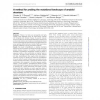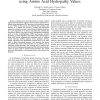24 search results - page 2 / 5 » Predicting the effect of missense mutations on protein funct... |
BIOINFORMATICS
2011
12 years 9 months ago
2011
Motivation: Proteins of all kinds can self-assemble into highly ordered β-sheet aggregates known as amyloid fibrils, important both biologically and clinically. However, the spe...
BMCBI
2007
13 years 5 months ago
2007
Background: Genome-wide association studies of common diseases for common, low penetrance causal variants are underway. A proportion of these will alter protein sequences, the mos...
CIBCB
2005
IEEE
13 years 11 months ago
2005
IEEE
— Proteins have been discovered to contain ordered regions and disordered regions, where ordered regions have a defined three-dimensional (3D) structure and disordered regions d...
IJCNN
2006
IEEE
13 years 11 months ago
2006
IEEE
— The ability to identify protein binding sites and to detect specific amino acid residues that contribute to the specificity and affinity of protein interactions has importan...
ARTMED
2004
13 years 5 months ago
2004
Successful secondary structure predictions provide a starting point for direct tertiary structure modelling, and also can significantly improve sequence analysis and sequence-stru...


